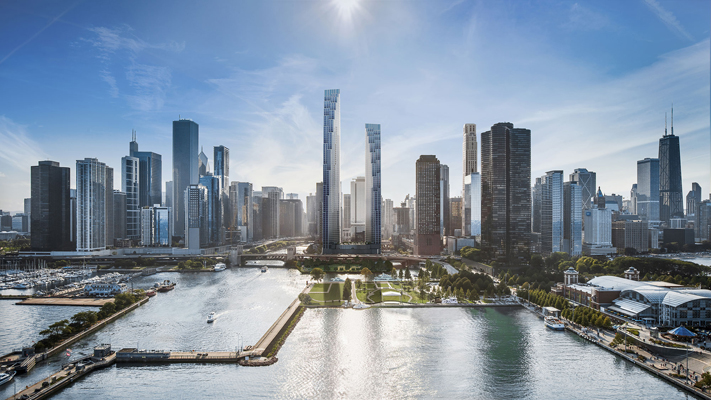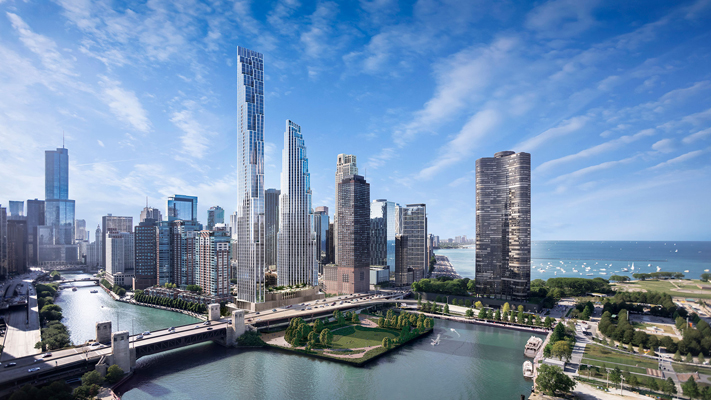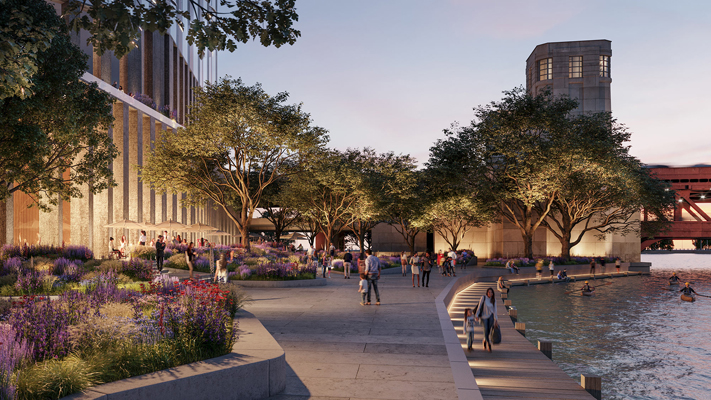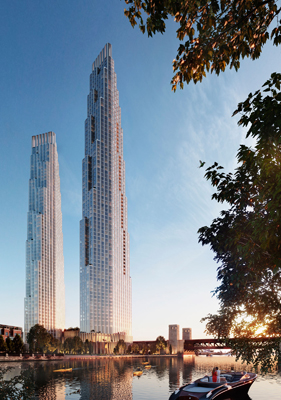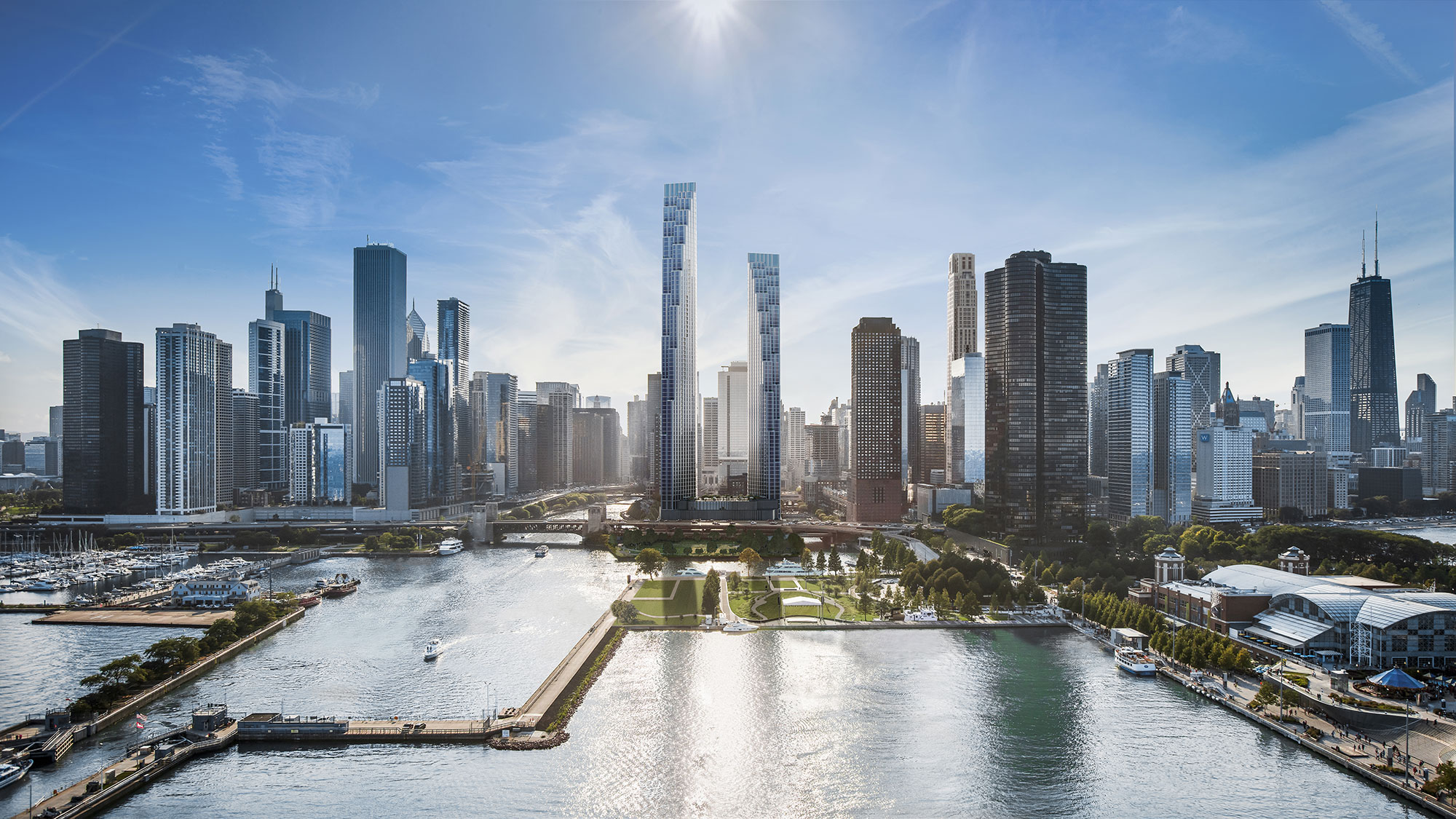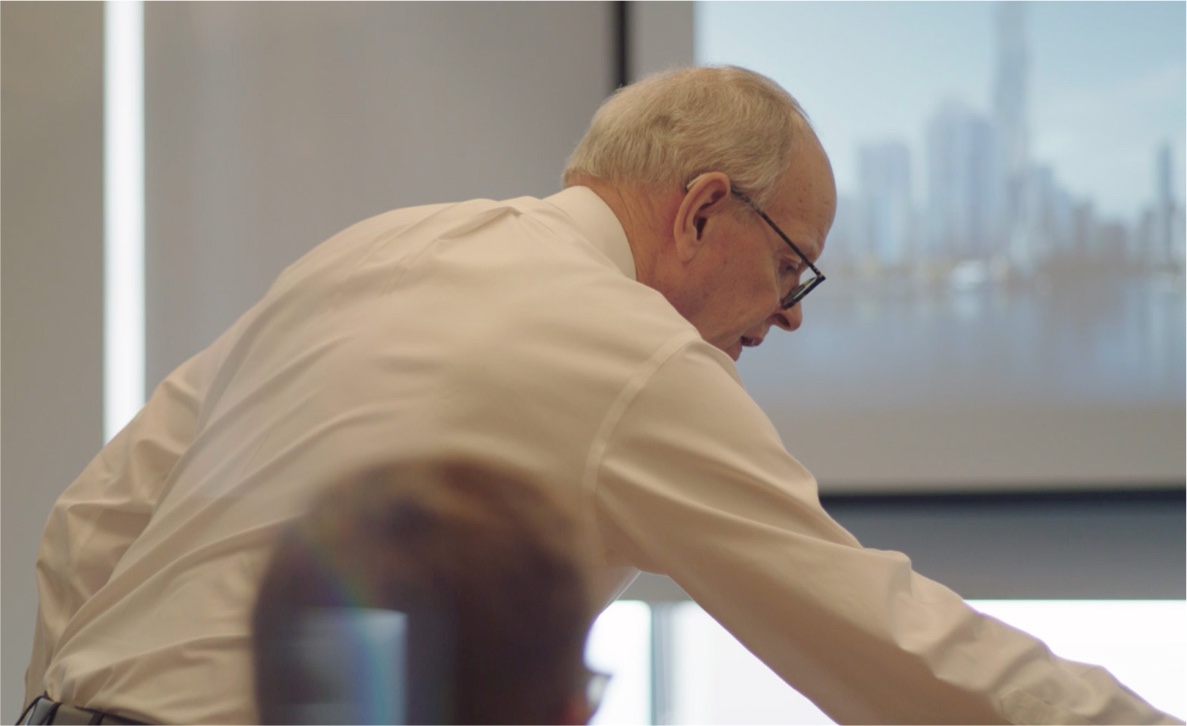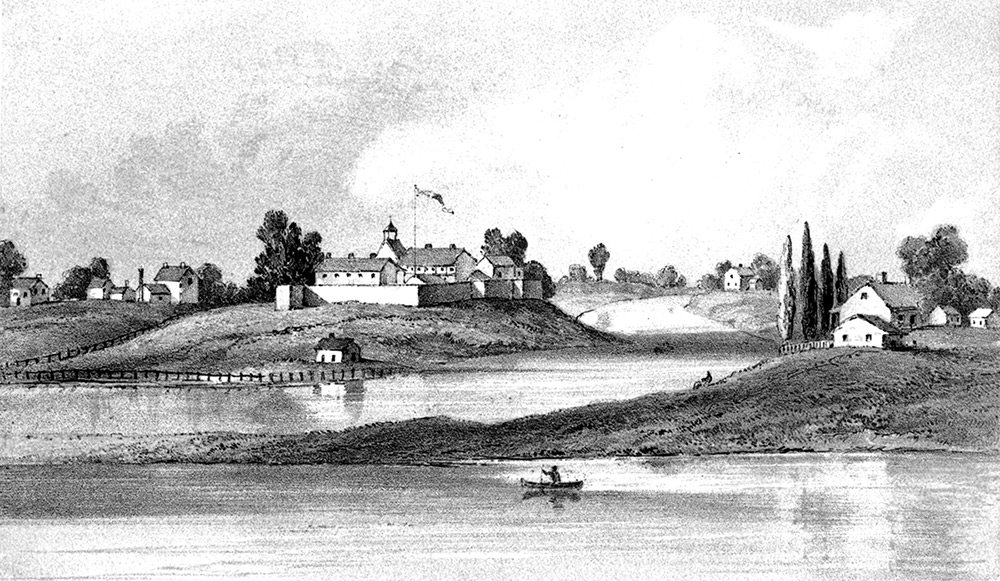
400 Lake Shore Drive is a Chicago site like no other – a gateway that connects the origins of our city to modern-day Streeterville and the magnificent Chicago lakefront.
The story begins with the city’s first permanent settlement, which was established in the late 1700’s by Jean-Baptiste Pointe DuSable, a settler from present-day Haiti. The settlement, known as the “homesite,” was along the northern bank of the Chicago River, near present-day Michigan Avenue. DuSable resided there with his family and operated a farm and a trading post with far-reaching relationships that helped early Chicago flourish.
After a transfer of ownership, land that included the homesite was subsequently platted and sold as the "Kinzie Addition.” Extending from the banks of the Chicago River north to Chicago Avenue, and from State Street east to Lake Michigan, it is commonly known today as Streeterville. A prime location for shipping and manufacturing, the site where the river meets the lake became part of 46 acres of land that was granted to the new Chicago Dock & Canal Company by the city’s first Mayor, William B. Ogden, to promote commercial and industrial development.
Following the Great Chicago Fire of 1871, Chicago rebuilt at an accelerated pace. Home to the world’s first skyscraper, it quickly established itself as a progressive 20th-century city. As part of that growth, the River East portion of Streeterville, which today includes both the 400 Lake Shore Drive site and nearby DuSable Park, thrived as a hub of industry. Among those businesses drawn to the prime river and lake frontage was Curtis Candies. Known for its Baby Ruth and Oh Henry! candy bars, the company moved its operations to the 400 Lake Shore Drive site in the 1920s and remained there until the late 1960s.
By the 1970s, a shift from manufacturing to residential and commercial uses was well underway. The DuSable Park site, which had been filled in by the U.S. Army Corps of Engineers in the late 1800s, was dedicated by the late Mayor Harold Washington in 1987, with the Chicago Park District receiving ownership of the land for the park’s development. But as the neighborhood around it flourished, DuSable Park remained on hold. Meanwhile, excitement ebbed and flowed over supertall concepts for the adjacent site at 400 Lake Shore Drive, with the Chicago Spire beginning construction in 2007 and stopping in 2008. A casualty of the global financial crisis, it left a large hole where a building was once planned.
Today, 400 Lake Shore Drive and a park honoring the first Chicago settler, Jean Baptiste Pointe DuSable, will mark a new chapter for this historic corner of downtown. Designed in partnership with American architect David Childs with Skidmore, Owings and Merrill (SOM), the sister towers will form the eastern gates to Chicago, transforming the downtown skyline and framing breathtaking lake-to-city and city-to-lake views. Most notably, the towers will complete the missing stitch in Chicago’s urban fabric, connecting downtown to the lakefront through the realization of a vision that’s inspired by the past, rooted in the present and designed for the future.
Positioned on the last waterfront site where Lake Michigan meets the Chicago River, the development of the 400 Lake Shore Drive site provides an opportunity to strengthen the city’s connection to the Chicago River and Lake Michigan through the creation of beautiful public spaces. Related Midwest has worked with its partners to create an inspired mixed-use project that meets growing demand for waterfront homes in the heart of downtown Chicago and pays tribute to Chicago’s architectural heritage.
400 Lake Shore Drive has been meticulously designed to reflect its setting: where the Chicago River meets Lake Michigan, on a site that once was home to Chicago’s founder, Jean-Baptiste Pointe DuSable.
The project’s sister towers, designed by David M. Childs with Skidmore, Owings & Merrill, will vary in height and be set at a slight angle to one another, forming a gateway that offers spectacular views along the lakefront and river corridors. Both buildings will be constructed of glass and terra cotta, with intricate metal detailing. Terra cotta, popularized by the first Chicago School, is inseparable from the city’s architectural tradition, gracing the façades of landmarks such as the Wrigley Building, the Reliance Building, The Sullivan Center (formerly Carson Pirie Scott & Co. Building), and The Rookery. At 400 Lake Shore Drive, the classic material will be used to create a contemporary rippling façade for both towers, symbolic of the surrounding waters. Another hallmark of the Chicago School—the “Chicago window”—will be reinterpreted through a series of bay windows.
Reminiscent of a waterfall, the cascading silhouette of each tower will form expansive outdoor terraces that extend individual residences beyond their walls. Placed at carefully proportioned intervals, these outdoor living areas will present a rare opportunity to enjoy sweeping, 180-degree views of the adjacent lakefront, river and cityscape.
The space between the towers will transform with each angle, sometimes framing a nearby building or opening a view to the sky above. An “urban room” at the end of East North Water Street will mark the moment of arrival for residents and guests, integrating distinctive plantings and art. Adjacent to the towers, an expanded Riverwalk will bridge the gap between downtown and the lakefront, connecting to a reimagined DuSable Park—a verdant space in the heart of the city that will be Chicago’s newest lakefront destination.
As one of Chicago’s premier residential and destination neighborhoods, Streeterville offers world-class experiences that highlight the best of the city. Once a sandbar along Lake Michigan claimed by eccentric George Streeter in 1886, Streeterville has evolved into a centerpiece for Chicago, bounded by the natural beauty of Chicago’s lakefront to the east; Oak Street to the north; the iconic Magnificent Mile to the west; and the Chicago River to the south.
A sought-after location to live, work and play, Streeterville is home to some of Chicago’s finest restaurants, a vibrant nightlife scene, luxury brands and renowned landmarks such as the Wrigley Building, Tribune Tower, John Hancock Center, 860-880 Lake Shore Drive, and the Drake Hotel. Streeterville is also home to top-ranked Northwestern Memorial Hospital and the Ann & Robert H. Lurie Children’s Hospital of Chicago, as well as downtown campuses for Northwestern University and Loyola University.
An enclave of art, culture and leisure greets Streeterville residents at every corner, with attractions such as the Lookingglass Theatre, Chicago Shakespeare Theater, Museum of Contemporary Art, The Arts Club of Chicago, Broadway Playhouse at Water Tower Place and the Chicago Children’s Museum. Stunning parks and outdoor spaces for all ages dot the neighborhood, including Michael Van Valkenburgh’s new 1.7-acre Bennett Park, Oak Street Beach and the Chicago Riverwalk, a 2017-2018 winner of the prestigious Urban Land Institute’s Global Design for Excellence Awards.

David M. Childs is consulting design partner with Skidmore, Owings & Merrill in New York. A graduate of Deerfield Academy, Yale College and the Yale School of Art and Architecture, Childs joined SOM in 1971 and became a senior design partner in 1984.
Widely recognized for his visionary designs for projects in cities around the world, Childs has led many of SOM’s most influential, large-scale complex projects in recent decades. 400 Lake Shore Drive is Childs’ third collaboration with Related and their first project together in Chicago. He and Related have worked together in New York City on the twin towers of the Time Warner Center at Columbus Circle, which were completed in 2003, and are currently working on 35 Hudson Yards, which is anticipated to be completed in 2019.
Childs has served as the Chairman of the National Capital Planning Commission and the Chairman of the Commission of Fine Arts in Washington, both Presidential appointments. Among other institutions, he has been actively engaged on the boards of the American Academy in Rome (Chairman), the Municipal Art Society (Chairman), the National Building Museum (Chairman), the Museum of Modern Art, the Architectural League, and the National Housing Partnership Foundation. He is a Fellow of the American Institute of Architects.
Skidmore, Owings & Merrill LLP (SOM) is one of the largest and most influential architecture, interior design, engineering, and urban planning firms in the world. Founded in 1936, SOM has completed more than 10,000 projects in over 50 countries and is renowned for its iconic buildings and commitment to design excellence, innovation, and sustainability.
SOM has worked with Chicagoans to shape their city for more than 80 years. From Chicago’s tallest buildings—including the Willis Tower and John Hancock Center—to civic and cultural projects like the Millennium Park master plan, the award-winning Chicago Public Library Chinatown Branch, the UI LABS Digital Manufacturing and Design Innovation Institute, and the Chicago Symphony Center, SOM is committed to creating transformative, dynamic, enduring spaces at all scales.
400 Lake Shore Drive establishes a new and dazzling place in history at the intersection of the Chicago Riverwalk and Lake Michigan. Tucked away in the “hidden east end” of Streeterville, it’s a place that will honor Chicago’s founding father, Jean-Baptiste Pointe DuSable, and two of our city’s greatest natural assets.
Along the northern banks of the Chicago Riverwalk, the development of 400 Lake Shore Drive also forms a new pedestrian walkway that will connect immediately west to the existing River Esplanade, also known as DuSable Founders Way. The public walkway will be the final piece of a pedestrian connection between the Riverwalk and the lake. It will pass beneath Lake Shore Drive to a natural endpoint at DuSable Park.
The 1.25-mile connected path known as the Chicago Riverwalk infuses historic architecture with contemporary designs, serving as a backdrop for social, cultural and recreational activities. Visitors can rent a kayak, embark on an architectural cruise, dine al fresco or stroll along the waterfront while taking in the views. Educational opportunities are available through the McCormick Bridgehouse & Chicago River Museum, which features the history of the Chicago River and its movable bridges, while the splash fountain, floating wetland gardens and fishing piers are ideal for family outings. A stepped River Theatre connects the award-winning Riverwalk to Upper Wacker Drive, providing a venue for public programming. Additional stairways along the Riverwalk provide access points to many downtown streets, including North Michigan Avenue, known as Chicago’s ‘Magnificent Mile’, with premier shops and restaurants. On the eastern portion of the Riverwalk, just west of 400 Lake Shore Drive, sits the Nicholas J. Melas Centennial Fountain, with a cannon that shoots an arc of water over the Chicago River each hour during summertime.
With the development of 400 Lake Shore Drive, Chicagoans and visitors to our world-class city will be able to continue their journey from the Riverwalk to the lakefront. And those who live and stay in these legacy towers, whose cascading silhouettes draw inspiration from the flowing waters below, will have a front-row seat to all Chicago has to offer—from the place where it all began.
In honor of Jean-Baptiste Point DuSable’s legacy as the founder of modern Chicago, Related Midwest is contributing $10 million towards the completion of DuSable Park. Led by the Chicago Park District, building DuSable Park will involve a collaboration among all stakeholders to craft the best plan and honor the legacy of Mayor Harold Washington, who set aside land for the park 30 years ago.
Related Midwest shares Chicago’s commitment to creating and preserving green space and parklands, as evidenced by nearby projects in Streeterville like Bennett Park, an $8 million, 1.7-acre park designed by Michael Van Valkenburgh Associates. Related Midwest will also improve the pedestrian experience under Lake Shore Drive, connecting DuSable Park and 400 Lake Shore Drive via bright new public walkways that would pass under the highway.
Up until a few days ago, the main meeting room at Skidmore, Owings & Merrill’s Chicago office was secured with a padlock and its glass window walls covered up with paper. This was done to prevent prying eyes from getting a glimpse into the team’s latest project, says Michael Pfeffer, a former SOM architect who was poached two years ago by mega-developer Related Midwest to help oversee big undertakings in Chicago. After years of planning, SOM and Related Midwest finally took the wraps off of their latest proposal this week, unveiling a pair of dramatic towers for 400 N. Lake Shore Drive, or as most Chicagoans know it, the site of the failed Chicago Spire skyscraper (more background on the failed supertall tower here).
Looking to make good on its pledge to deliver an architecturally significant successor to the failed Chicago Spire project, developer Related Midwest plans a pair of gleaming glass and terra-cotta towers at 400 N. Lake Shore Drive in what is arguably the most highly anticipated architectural reveal in recent Chicago history.
Real estate development company Related Midwest unveiled a vision Tuesday for the site of what would have been the Chicago Spire, where the Chicago River meets Lake Michigan in the city’s Streeterville neighborhood.
More than three years after taking title to the land where the audacious Chicago Spire was once envisioned, and more than two years after soliciting designs from a half-dozen architecture firms, Related Midwest on Tuesday unveiled a bold plan for the waterfront site.
Related Midwest made its first pitch to the public for a bold residential-hotel project on a premier downtown property, the Streeterville site of the failed Chicago Spire.
